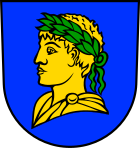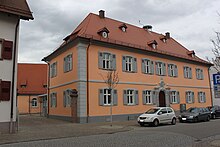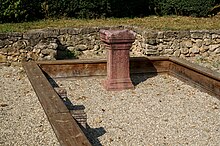Riegel at the Kaiserstuhl
| coat of arms | Germany map | |
|---|---|---|

|
Coordinates: 48 ° 9 ' N , 7 ° 45' E |
|
| Basic data | ||
| State : | Baden-Württemberg | |
| Administrative region : | Freiburg | |
| County : | Emmendingen | |
| Height : | 184 m above sea level NHN | |
| Area : | 18.34 km 2 | |
| Residents: | 3962 (December 31, 2018) | |
| Population density : | 216 inhabitants per km 2 | |
| Postal code : | 79359 | |
| Area code : | 07642 | |
| License plate : | EM | |
| Community key : | 08 3 16 037 | |
| Address of the municipal administration: |
Hauptstrasse 31 79359 Riegel am Kaiserstuhl |
|
| Website : | ||
| Mayor : | Daniel Kietz | |
| Location of the municipality of Riegel am Kaiserstuhl in the district of Emmendingen | ||
Riegel am Kaiserstuhl is a municipality in the district of Emmendingen in Baden-Württemberg, Germany.
geography
Geographical location
Riegel spreads on the northeastern edge of the Kaiserstuhl . It is located a few hundred meters northwest of the confluence of the Glotter in the Dreisam and the confluence of the Dreisam and Alter Dreisam in the Elz tributary to the Rhine . In Riegel, the Leopold Canal is separated from the Elz; it flows towards the Rhine in a more direct way. Directly south of the village is the St. Michaels Mountain ( 241 m above sea level ) with the Michaelskapelle .
Community structure
The municipality of Riegel am Kaiserstuhl includes the village of Riegel, the courtyards Kunstmühle and Riedhöfe and the residential areas at Riegel-Malterdingen train station, Ries residential building, Willmann residential building, Ziegelei and Zum Bad. The abandoned town of Helsolczhein is located in the municipality .
climate
| Riegel near Emmendingen (Mundingen) | ||||||||||||||||||||||||||||||||||||||||||||||||
|---|---|---|---|---|---|---|---|---|---|---|---|---|---|---|---|---|---|---|---|---|---|---|---|---|---|---|---|---|---|---|---|---|---|---|---|---|---|---|---|---|---|---|---|---|---|---|---|---|
| Climate diagram | ||||||||||||||||||||||||||||||||||||||||||||||||
| ||||||||||||||||||||||||||||||||||||||||||||||||
|
Monthly average temperatures and precipitation for Riegel near Emmendingen (Mundingen)
Source: [2]
|
||||||||||||||||||||||||||||||||||||||||||||||||||||||||||||||||||||||||||||||||||||||||||||||||||||||||||||||||||||||||||||||||||||||||||||||||||||||
history
The area of today's municipality of Riegel has about 7000 years of settlement history, which goes back to the Neolithic Age. Finds from the cultures of the band ceramics , Rössen , Michelsberger and bell beakers are proven. From the 1st and 2nd centuries BC Various Bronze, Hallstatt and Celtic findings come from the 4th century BC . In 2001 a Celtic gold coin treasure was found. Archaeological evidence is primarily of Roman settlements such as the Roman military camp that was built in the middle of the 1st century and the larger settlement ( vicus ) that developed afterwards . While the finds reach into the 4th century, the 2nd century is considered the heyday, when the Roman settlement “Rigola” was the administrative center for today's Breisgau .
In the 6th and 7th centuries, a Franconian royal court with a church dedicated to St. Martin was built on the Fronhofbuck . The will of the bishop Heddo of Strasbourg from the year 762 has proven to be a forgery of the years 1111 to 1125 and sprang from the successful pursuit of Ettenheimer monks from Emperor Henry V to be confirmed in their possessions . After a first documentary mention on July 13, 781, Hildegunt gave various goods from her property in Riegel to the Lorsch Monastery . From 952 it came to the monastery of Einsiedeln by order of King Otto I von Guntram the rich .
On March 4, 1179, the Zähringen Duke Berthold IV stayed with his son with his Ministerial Wernher von Roggenbach in the Riegeler Burg . Around 1200 the community Riegel received Mauer, Graben and the gates Schäfertor, Wassertor and Dörl . The castle came to the Lords of Üsenberg as a fief in 1218 . In 1353, Einsiedeln Abbey sold its property in Riegel to the Freiburg patrician Johann Malterer , whose eleven grandchildren were joint heirs and founded the Riegel community . Via Johann Malterer, the place in front of Austria came under the Habsburg rulership in 1368, where it remained for four and a half centuries. The Dominican convent of St. Katharina was founded in 1450 and dissolved again in 1779. The Einsiedeln monastery sold its patronage rights to the Ettenheimmünster monastery in 1483. During the Thirty Years War , Riegel was besieged on November 5, 1633 by troops under the Swedish General Horn and badly damaged. In 1651 a new, supplemented municipal lordship order was issued, while the place only had 150 inhabitants. In 1784, today's town hall was built as a community mansion.
In 1806 Riegel came to the Grand Duchy of Baden . Important infrastructural measures in the 19th century were the construction of the Leopold Canal from 1837 to 1842, through which the floods through Elz and Dreisam were largely prevented. Riegel received a rail connection for the first time in 1845 with the construction of the Baden main line from Mannheim to Basel.
politics
Administrative association
Riegel is a member of the Nördlicher Kaiserstuhl community administration association based in Endingen; other member communities are the city of Endingen and the communities of Bahlingen am Kaiserstuhl , Forchheim (Kaiserstuhl) , Sasbach am Kaiserstuhl and Wyhl am Kaiserstuhl .
Municipal council
The local elections on May 25, 2014 with a turnout of 47.5% (- 8.5 percentage points) led to the following result:
| CDU | 45.1% | + 7.1 | 5 seats | ± 0 |
| SPD | 32.0% | - 0.6 | 4 seats | ± 0 |
| FWG | 22.9% | - 6.6 | 3 seats | ± 0 |
Municipal coat of arms
Since the first partial lordship order in 1491, the municipal coat of arms has shown a head. In the 19th century, the coat of arms was set as a Roman head wreathed with green laurel in gold on a blue background, which is supposed to indicate the Roman past of the place. According to recent research, it is said to be a transcription error, since older community seals depict a heathen head with a love ribbon, which is probably the depiction of Saint Mauritius .
Community partnerships
Since 1995, a community partnership with the municipality Champhol around Chartres in the Eure-et-Loir in France .
Economy and Infrastructure
traffic
Riegel is connected to the national road network via the federal motorway 5 (Alsfeld - Weil am Rhein). In 1845, Riegel received a railway connection through the Riegel station outside the village (renamed Riegel-Malterdingen in 2011) on the state railway line of the Badische Hauptbahn ( Rheintalbahn Mannheim - Basel ), which is now operated by Deutsche Bahn AG . In 1894 the Kaiserstuhlbahn was built from Gottenheim via the Riegel am Kaiserstuhl Ort station to Endingen am Kaiserstuhl and a branch from Riegel am Kaiserstuhl Ort to Riegel-Malterdingen to the main line, followed by the remnant Endingen - Breisach am Rhein in 1895 . As a private railway, the Kaiserstuhlbahn belonged to the Süddeutsche Eisenbahn-Gesellschaft (SEG) for a long time and is now operated by the Südwestdeutsche Landesverkehrs AG (SWEG) . The line was electrified in 2019. The bolt-Malterdingen Station is the starting point of the museum train Rebenbummler , which operates since 1978 from May to October on the Kaiserstuhlbahn.
Established businesses
The brewery company Meyer & Söhne AG , founded in 1834, also known as the Riegeler Brewery in common parlance , has belonged to the Fürstlich Fürstenbergische Brewery in Donaueschingen since 2000 . The brewery location and brand were retained for the time being. In October 2004 the Fürstenberg brewery was taken over by Brau Holding International AG ( Heineken , Schörghuber ). The brewery facilities in Riegel have now been completely shut down. Various types of beer from the Riegeler Bier brand are now brewed in the Fürstenberg house in Donaueschingen. The art hall messmer , lofts and the small brewery Römerbräu have been located in the buildings of the former Riegeler brewery since 2006 .
Today's industrial companies include Agrano GmbH & Co., a producer of various biological yeast products (a company in the Oetker Group) and ZIKUN Fahrzeugbau GmbH , which was founded in 1971 and specializes in the design and construction of special vehicles z. B. Fire and beverage vehicles, trailers, etc. specializes. Furthermore, the company Herbert Hipp Verpackungen GmbH, the paint center Schultis, the branch Riegel of the Rhenus Data Office GmbH , and a warehouse of the company Lekkerland are located in Riegel.
Education and culture

Riegel has two kindergartens with three groups and five groups and with the Michaelschule a primary school .
In the Museum bars about 300 archaeological finds from the Roman past bolt shown since of 2006. In 1974 a Mithras temple was uncovered, one of the stops on the archaeological circular route, which also shows the Celtic and medieval past of Riegel. In 2006, the community and the history association were awarded the Baden-Württemberg Archeology Prize for setting up the museum and the circular route . In January 2012, the Riegel Museum was reopened in the rear part of the old school community center. Department II with the subject of aerospace technology was added. After the end of the Second World War , the rocket researchers recruited by France and their families came to Riegel. At that time, her office was located in the Arche restaurant. The results of their research flowed into the development of the European Ariane rocket and thus into civil aviation.
In the disused brewery castle of Riegel, built in 1875, the Messmer art gallery was opened on June 20, 2009 at the confluence of the Dreisam, Elz and Glotter rivers with the exhibition Homage to André Evard . There are 900 m² of exhibition space and a large outdoor area for sculptures available to art. A large number of artists also live in the village, who organize the open studio day every year.
With the Kumedi , the municipality has had a cabaret theater since 1997 in the former reception building of Riegel Ort train station, which is also called the head station . It was founded by Klaus Spürkel and his wife Elisabeth Fünfgeld.
The community also describes itself as the cultural gateway to the Kaiserstuhl .
Sacred buildings
Parish Church of St. Martin
The Catholic parish church of St. Martin was built between 1743 and 1749 by the master builder Franz Rudhart and is one of the most beautiful baroque churches in Breisgau. The slightly retracted choir with a semicircular apse is attached to the single nave nave . The church tower integrated into the elegantly curved facade has an onion dome. Well-known artists contributed to the rich artistic equipment. The Rococo stucco work was done by Hans Georg Gigel from the Gigl family of artists , while Benedikt Gambs created the altar and ceiling paintings. The first organ came from the workshop of Johann Andreas Silbermann in Strasbourg. In a fire on October 28, 1936, the original interior was largely destroyed and reconstructed during the subsequent reconstruction. After partial destruction in World War II, the baroque furnishings were restored again and recently extensively renovated.
Michael's Chapel
The Michaelskapelle is one of the landmarks of the place and is visible from afar on the Michaelsberg. It was first mentioned in a document on the occasion of its rededication in 969. As a castle chapel, it belonged to Riegel Castle, which was first mentioned in 1160 and destroyed in 1356 . Timbers from the years 1283–1293 are built into the roof structure, around 1465 the chapel was renewed and with the late Gothic choir was largely given its current appearance. The Michael's Chapel also served as a pilgrimage church.
Cemetery chapel
When the cemetery was expanded in 1901, the directors of the Meyer & Söhne brewery company decided to donate a cemetery chapel to the community . In July 1903 the architect Paul Meißner from Darmstadt was won. On August 5th, the excavation of the excavation began, and a Roman cellar was discovered as a remnant of a Roman house. The completion of the chapel in the typical neo-baroque style of the brewery took until 1907. The inauguration took place on October 29, 1907 and the donation to the community on January 31, 1908. In 1973, the neighboring consecration hall was built.
Käppele
The so-called Käppele or Kreuzheusslin / Kreuzkäpplin building was mentioned as early as 1555 and is today near the Protestant church. The townscape from 1709 clearly shows that it is outside the town in front of the village wall across from the Schäfertor. The building itself is quite small in its base area of approx. 2 m × 2.5 m and executed in an open construction. This allows a direct look at a figure of the risen Christ standing inside. In front of it, a knee bench serves as a barrier.
Protestant church
In 1897, 22 men voted to build a prayer room at a meeting. After Jakob Kaderlin had donated the building site and the Lepp and Kaderlin families guaranteed a loan, the Protestant church was built within nine months in 1898 , at that time still outside the village. The church is in the neo-Gothic style.
Sons and daughters of the place
- Anton Anreith (1754–1822), sculptor who worked mainly in Cape Town
- Wilhelm Walliser (1831–1898), sculptor who worked mainly in Freiburg
- Heinrich Klein (1919–2011), civil engineer and inventor of the goal wall
Web links
- Homepage of the community of Riegel am Kaiserstuhl
- Riegel on the northern edge of the Kaiserstuhl
- Riegel and the Romans
- private homepage about Riegel am Kaiserstuhl
- Discover the entry on regional studies online leobw
Individual evidence
- ↑ State Statistical Office Baden-Württemberg - Population by nationality and gender on December 31, 2018 (CSV file) ( help on this ).
- ^ The state of Baden-Württemberg. Official description by district and municipality. Volume IV: Freiburg administrative region. Kohlhammer, Stuttgart 1978, ISBN 3-17-007174-2 . Pp. 234-235.
- ^ Mechthild Michels: 7000 years of settlement history Riegel am Kaiserstuhl
- ↑ Regesten the bishops of Strasbourg , Volume I, Part II, p 224f ; Hansmartin Schwarzmaier : The monasteries of the Ortenau and their convents in Carolingian times . In: Zeitschrift für die Geschichte des Oberrheins 119 (1971) pp. 1–32, here especially pp. 4–6 ( PDF, 2.35 MB ); Database of monasteries in Baden-Wuerttemberg on the Ettenheimmünster Benedictine Abbey - history : " Neither can one [...] assume a secure document situation with regard to Eddo's will. Current research suggests the document that the monastery and the monks resident there had a rich legacy certified the authenticity and began its creation between 1111 and 1125, during the investiture controversy.
- ↑ Karl Minst, Lorscher Codex Volume IV. 1970, p. 208.
- ^ H. Witt: Outline of the history of Burkheim in: Stadtverwaltung Burkheim and Winzergenossenschaft Burkheim: 1200 years Burkheim , Burkheim, 1963, p. 16
- ↑ see Dominican convent Riegel in the database of monasteries in Baden-Württemberg of the Baden-Württemberg State Archives
- ↑ Baden-Württemberg State Statistical Office
- ↑ District Office Emmendingen: Book of Arms of the District of Emmendingen
- ↑ History Association Riegel e. V .: Riegeler Almanach 2011
- ↑ Our travel offers - MODX Revolution. Eisenbahnfreunde Breisgau, accessed on June 18, 2019 .
- ↑ Foundation and concept. kumedie.de, accessed on June 18, 2019 .










